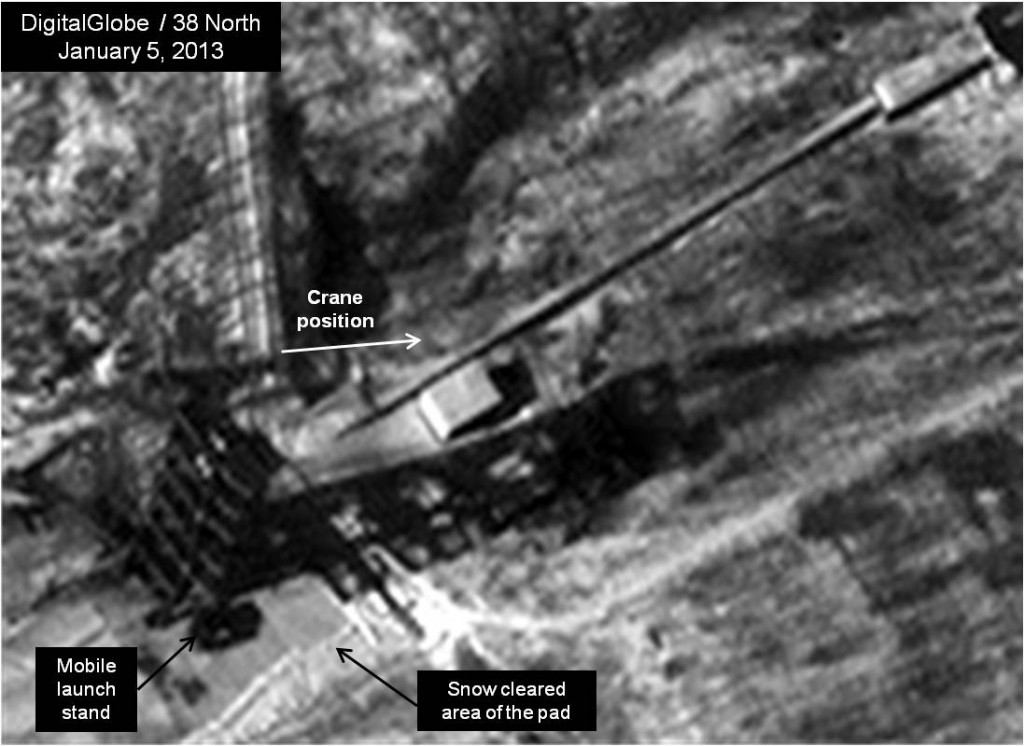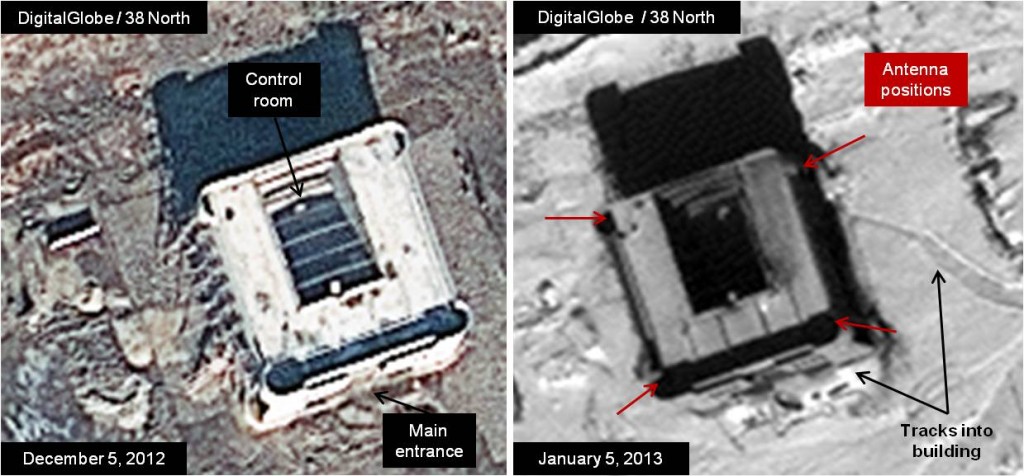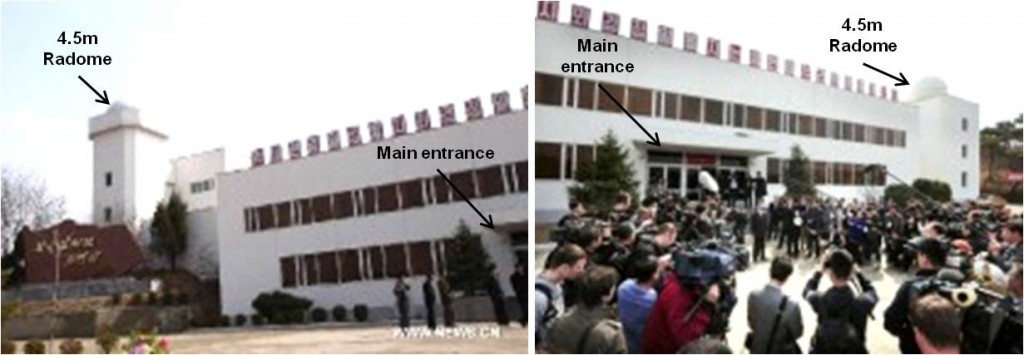New Developments at the Tonghae Rocket Test Site
Summary
While the Sohae rocket test facility was the focus of international attention in 2012, construction of new facilities at the Tonghae Satellite Launching Ground (commonly referred to as Musudan-ri), previously slowed by the typhoons that ravaged the east coast of North Korea last summer, has made important progress since late October 2012.
Commercial satellite imagery through January 2103 confirms activity at the old launch pad, possibly to modify it in preparation for an upcoming test of a liquid-fueled rocket. While it would be premature to reach that conclusion without more recent imagery, press reports have speculated that the DPRK is planning to conduct the first launch of the Musudan intermediate-range or the KN-08 long-range rocket, both mobile missiles. An additional possibility is another launch of an Unha rocket.
Imagery of the new launch pad and support buildings indicates that Pyongyang will be able to test rockets perhaps three to four times the size of the Unha when construction is completed, possibly in 2016, depending on the pace of construction.
Analysis of construction activities around the new launch pad has revealed evidence that Pyongyang’s rocket program may be receiving assistance from Iran. A new flame trench covering to protect large rockets from exhaust gases is similar to the covering used at a new launch pad at the Semnan Launch Complex in Iran. Also, propellant conduits under construction for the new launch pad and rocket engine test stand are similar to those built at Semnan.
Activity at Old Launch Pad: Preparation for a New Test?
Commercial satellite imagery beginning in August 2012 and continuing into early 2013 shows activity at the old launch pad at the Tonghae Satellite Launching Ground (commonly referred to as Musudan-ri) first used for the Taepodong-1 launch in 1998, then modified for the first Unha rocket tested in 2006, and last used in April 2009 for the Unha-2 firing. That activity may be related to another round of modifications intended to support future launches of the Unha rocket or possibly another liquid-fueled missile.
First observed in August 2012, activity continued in October with two vehicles parked adjacent to the gantry’s south side and an unidentified light color material seen in front of it (figure 1). In December 2012 there was activity at the pad and the crane was positioned over its front. By January 2013, one half of the pad around the gantry had been cleared of snow and the crane was now seen pointing in a northern direction (figure 2).
Figure 1. Activity at the old launch pad on October 29, 2012.

Figure 2. Activity at the old launch pad on January 5, 2013.

Recent unconfirmed press reports indicate that the North may be preparing for a test of either the new KN-08 long-range missile or the Musudan intermediate-range rocket, both road mobile systems. Activity at the old launch pad may be related to such a test, but since imagery more recent than early January is unavailable, it would be premature to reach that conclusion. Also, at the time of the last photo capture, there was little if no activity at parts of the test range—old assembly building, instrumentation site, fuel storage areas, and motor pool—that would be expected if a test were planned in the short-term.
Since both the Musudan and KN-08 are road mobile missile systems and have been displayed with their transporter-erector-launchers (TELs), it is unclear whether the rockets would be launched from a fixed gantry tower. Using the infrastructure of an existing test range has advantages for a developmental missile launch, however. The first launch of either missile would benefit from a gantry’s enclosed workspace for checkout and fueling. The gantry tower would eliminate the need to fuel the missile and generate electrical power with support vehicles; it would also provide a level of protection from the elements. If the tower is used for the launch, the propellant and electrical connections would need to be modified to fit one or both of these missiles. This could explain work underway there since last summer. Moreover, the mobile launch stand would need to be modified or replaced since the 2.4m diameter of the Unha is larger than either of these missiles. Modification of the mobile stand could be completed inside the missile assembly building and then moved to the pad.
Using the Tonghae launch center for a full range test of either the Musudan or the KN-08 would require overflying northern Japanese territory. Highly lofted or reduced range tests could be conducted without violating Japan’s airspace.
Major Developments at New Launch Pad
Three major developments at the new Tonghae launch pad reinforce previous conclusions by 38 North that the facility is being upgraded to fire larger rockets and that the North Koreans may be receiving Iranian assistance (figure 3):
A New Flame Trench Covering: The most striking addition to the launch pad is a covering over the first 26m of the flame trench, probably intended to direct exhaust gasses away from the rocket and gantry tower towards the wide mouth of the trench. (This covering may also be porous to prevent pressure from building up by allowing some exhaust gasses to escape.) First seen in August 2012 stacked alongside the trench, by October it had been attached to 14 horizontal beams that run across the trench. Also, two stacks of finer material seen alongside the pad in October were gone two months later and may have also been installed.[1]
While no North Korean launch pad or engine test stand has used this approach to keep exhaust gasses away from the rocket during launch, the large new pad under construction at the Iranian Semnan launch complex may use the same technique. Because the rockets that will be launched from these pads are so much larger than the current systems, protecting them from exhaust gasses becomes an important priority.[2]
Figure 3. The new launch pad under construction.

Large New Fuel Storage Tanks: The western of the two propellant buildings had three large storage tanks installed between August and October 2012. (The second building had no tanks installed as of early January 2013.) Each of the buildings has the capacity to house three cylindrical tanks measuring 13m long by 4m in diameter and two tanks measuring 9m long and 4m in diameter. (It is unknown whether or not these two additional tanks will be installed.) Each of the two larger tanks holds about 163,000 liters
for a total of 326,000 liters, and the smaller tank holds about 113,100 liters.[3] For comparison, the Unha-3 oxidizer tank recovered from the December 2012 test, measuring 7.6m long by 2.4m in diameter, only holds about 31,500 liters.
If these measurements are correct, the new launch pad could support a rocket three or four times larger than the Unha, similar to the mock-up reported to have been seen at a Pyongyang research and development facility in April 2012. The new construction at Tonghae, including the pad, a large assembly building, and launch control building, all point to the use of the test center in the future to launch large rockets.
New Propellant Conduit: A conduit to carry propellants to the pad along with electrical and communications service lines, large enough to allow technicians to work in them, connects the eastern propellant storage building to the newly identified launch control bunker and eventually will run over to the launch pad. On the other side of the launch pad, the conduit runs from the pad to under what will be the gantry tower and eventually to the west propellant storage building. These conduits, similar to those built at the Iranian Semnan launch complex for its new large launch pad and rocket engine test stand, show an Iranian influence in the DPRK’s launch site construction.
It should be noted that these major construction activities are taking place despite the fact that only a very poor dirt road leads to the pad area. While construction of a new road and bridges has begun, it has not yet been completed.
Progress at Launch Control Building
Construction has progressed rapidly on the new launch control building, a three-story structure that measures 35m by 45m and has four 7m diameter circular positions, one on each corner. The interior of the building has an opening that measures 17m by 26m that will be the location of the control room (figure 4).
The exterior work, with the exception of the roof over the control room, was continuing in December 2012, but was completed a month later. Seven supports are present for the building’s roof. The four circular positions are probably intended to mount antennas for tracking and collecting telemetry from rocket launches and satellites once in orbit. These positions will likely be covered by radomes. Two tracks in the snow leading into the building may indicate that some interior work was continuing in early January 2013.
Figure 4. Control building under construction at Tonghae.

When completed, this will be the DPRK’s fifth known major launch/satellite control room (table 1). The four new rooms have a balcony from which VIPs can view the launch on big screens in the front of the room. For comparison, the control room at the Sohae launch site appeared complete and the facility secured in December 2007, but was not used for a launch until April 2012.
Table 1. DPRK satellite and launch control room comparisons.
| Location | length & width (m) | Floor space (m2) | Completion |
| Tonghae old | 16×15 | 240 | 1995 est |
| GSCC Rm 1* | 31X13 | 400 | 2005 |
| GSCC Rm 2* | 32×14 | 450 | 2005 |
| Sohae | 26×16 | 415 | 2008 |
| Tonghae new | 26×17 | 440 | 2014 est |
| * General Satellite Control Center located outside of Pyongyang. | |||
The Sohae and new Tonghae control buildings are similar structures except the corners at Tonghae have three story towers for circular positions for antennas. Concrete towers mounting 4.5m radomes also flank the two control rooms at the General Satellite Control Center (GSCC) in Pyongyang (figure 6 shows two views of the front of the GSCC).
Figure 6. Media photos of the GSCC (April 10, 2012).

The presence of at least two radome-covered antennas may indicate that the new control building at Tonghae will also function as the North’s eastern satellite command and tracking station. For polar orbits, Tonghae’s location allows it to see an additional satellite orbit further east than Pyongyang’s GSCC.
Slow Construction at the New Assembly Building
Less than 100m west of the new control building is the large rocket assembly building still in the early stages of construction. In comparison with the control building, very little new work has been done since August 2012 (figure 7). Construction may pick up in the spring when equipment and construction supplies can be brought in.
Figure 7. Little construction progress on the new assembly building.

[1] This material may be steel mats to strengthen the concrete for the launch pad and collar that surrounds the circular opening into the flame trench.
[2] Just after launch, a rocket’s exhaust impinging on one of its sides would create a lateral force that its guidance system would have to counteract. To avoid this complication, most launch pads have two or three smaller flame trenches and/or cover the trench out to a significant distance. The old launch pad at Tonghae and the new one at Sohae have the trench covered out to the end of the pads. Because of the geography of the area, this pad has a single wide and long flame trench, so covering it would keep the exhaust away from the rocket.
[3] Since the storage buildings are the same size it is not yet possible to determine which one is for propellant and fuel.
